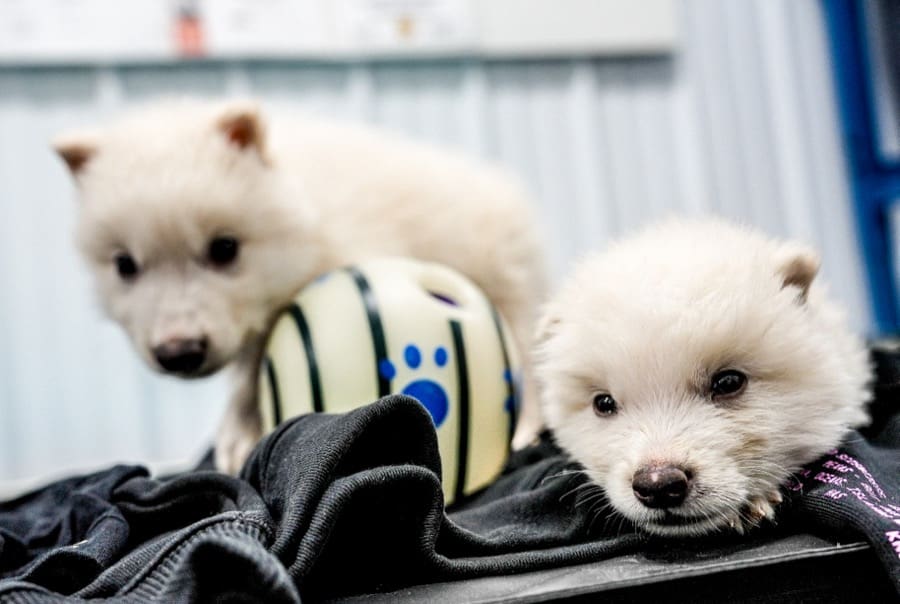On Monday morning, the world woke up to the news that an ancient species and the sigil of House Stark had been revived. Ladies and gents, the dire wolf, an apex predator that went extinct over 10,000 years ago, has apparently been brought back to life.
Wait, what?
A US-based biotech startup, Colossal Biosciences, has claimed that they’ve successfully brought the dire wolf back to life. If the name dire wolf sounds familiar to you, it’s because the real-world animals, which went extinct over 10,000 years ago, were used as a sigil of House Stark in author George RR Martin’s A Song of Ice and Fire book series. The books were adapted into the popular HBO TV series Game of Thrones.
We’ve also recently told you about Colossal Biosciences after their researchers genetically modified mice to grow woolly mammoth-like fur.
And now, the lab has revealed three adorable dire wolf puppies named Remus, Romulus and Khaleesi. The boys are named after the mythical founders of Rome who famously were suckled by a she-wolf after they were abandoned in the wilds of Italy, and the girl pup is named after the word for queen in the fictional language Dothraki from Martin’s books.
Ok, enough nerdy references. How did they do this?
Like with the woolly mice, researchers at Colossal, based in Texas, used genetic engineering and ancient, preserved DNA to decipher the dire wolf genome. They then rewrote the genetic code of the common grey wolf, the closest living ancestor to the dire wolf, to match it, and, using domestic dogs as surrogate mothers, brought Romulus, Remus, and their sister, Khaleesi, into the world during three separate births last year and early this year. “We are an evolutionary force at this point,” said Beth Shapiro, Colossal’s chief science officer, to Time Magazine. “We are deciding what the future of these species will be.”
So cool…. But why aren’t other scientists convinced?
Experts aren’t entirely convinced that our two good boys and one good girl aren’t dire wolves but genetically modified grey wolves. Speaking to the BBC, Paleogeneticist Dr Nic Rawlence from Otago University in New Zealand said that ancient dire wolf DNA – extracted from fossilised remains – is too degraded and damaged to copy or clone biologically. “Ancient DNA is like if you put fresh DNA in a 500-degree oven overnight,” Dr Rawlence told BBC News. “It comes out fragmented – like shards and dust. You can reconstruct [it], but it’s not good enough to do anything else with.” Rawlence isn’t alone in calling this out, but Colossal has not budged and insists that the project represents a de-extinction.
The general public also isn’t as impressed, with some saying that scientists are wasting money on frivolous projects when they could be curing cancer, while others warn that this is a bad idea, likening it to the 1993 classic movie Jurassic Park, where dinosaurs were brought back to life using genetic engineering, and things quickly go wrong.
So much drama… What’s next?
Now that the world knows dire wolves (or genetically modified grey wolves) are back, Colossal’s other projects involve bringing back the woolly mammoth, the dodo, and the thylacine, or Tasmanian Tiger, which went extinct in 1936 at Hobart Zoo in Tasmania.
Who knows, maybe years from now, Colossal can bring back the Tyrannosaurus Rex. We’re curious to see how fluffy they’d make it. For now, though, welcome back, little ancient ones. The world has changed quite a bit since your ancestors roamed it.
Tshego is a writer and law student from Pretoria. A keen follower of social media trends, his interests include high fantasy media, politics, science, talk radio, reading and listening to music.
He is also probably one of the only people left who still play Pokemon Go.
- This author does not have any more posts




